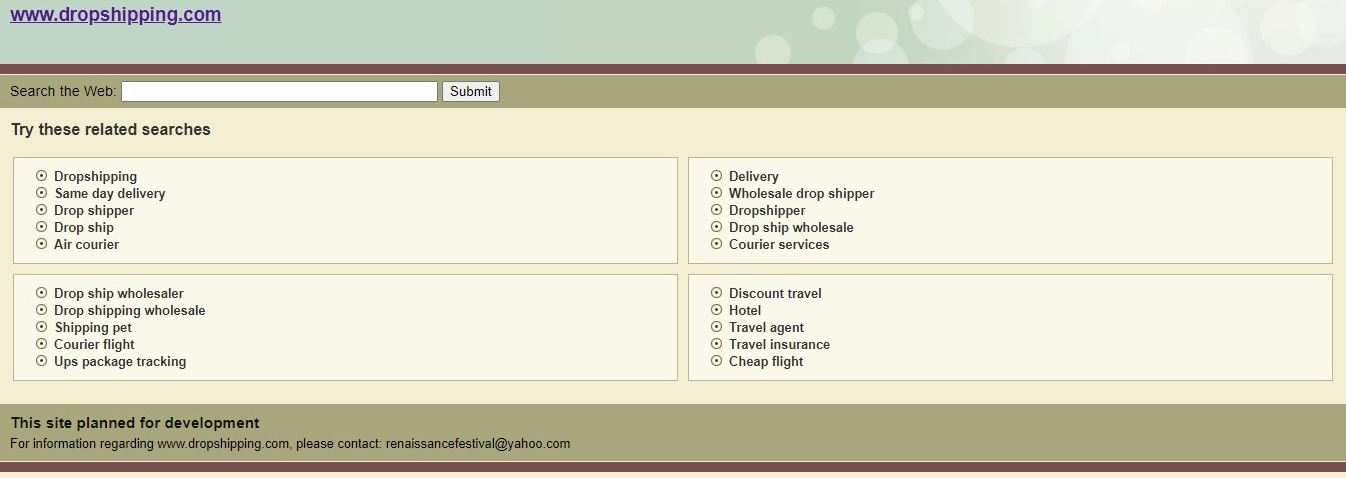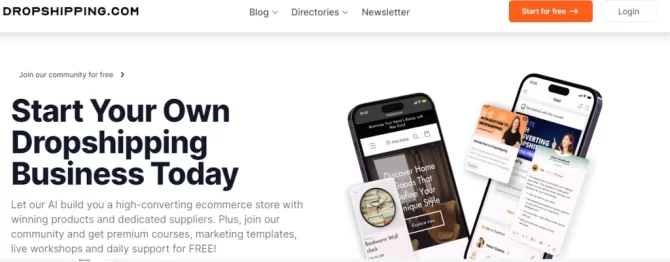Developing a dropshipping business involves a comprehensive process that integrates various elements and technologies to provide a seamless shopping experience for users. In this article, we will explore the key aspects of dropshipping business development, including understanding what is dropshipping, and how does dropshipping work. essential features of a successful dropshipping store, the stages of setting up a dropshipping business, and future trends in the dropshipping industry. By delving into these areas, you’ll gain a clear understanding of how to build and scale a thriving dropshipping business in today’s competitive e-commerce landscape.
What is Dropshipping?
Dropshipping is a retail fulfillment method where a store doesn’t keep the products it sells in stock. Instead, when a customer makes a purchase, the store buys the product from a third-party supplier, who then directly ships it to the customer. In essence, the retailer acts as an intermediary between the buyer and the supplier, handling the sales process without physically handling the inventory.
Definition and Concept
Dropshipping allows retailers (often referred to as dropshippers) to sell products without needing to maintain inventory or manage logistics. The retailer lists products on their online store, sets prices, and markets them to potential customers. When a customer places an order, the retailer forwards the order details and shipment information to the supplier or manufacturer.
Roles in Dropshipping
- Retailer (Dropshipper): The retailer sets up an online store, selects products to sell, and markets them to potential buyers. They handle customer inquiries, process orders, and manage customer relationships.
- Supplier (Dropshipping Supplier): The supplier stocks and fulfills the products. They may also handle shipping, returns, and other logistics associated with the product. Suppliers can range from wholesalers to manufacturers.
History and evolution of Dropshipping
Dropshipping has an interesting history, evolving from traditional retail practices to become a prominent business model in e-commerce today. Here’s an overview:
Origins of Dropshipping
Dropshipping traces its roots to the mail-order catalog era of the early 20th century. Companies would take orders from customers, and then send those orders to manufacturers or wholesalers who would directly ship the products to the customers. This allowed retailers to avoid holding inventory and reduce the costs associated with warehousing.
Key Milestones and Developments:
- 1950s-1960s: With the rise of direct marketing and catalog sales, dropshipping gained traction as a method for businesses to expand their reach without investing heavily in inventory management.
- 1990s: The advent of the internet brought new opportunities for dropshipping. Online marketplaces and e-commerce platforms enabled retailers to connect directly with suppliers, streamlining the process of sourcing and selling products.
- Early 2000s: Platforms like eBay and Amazon popularized dropshipping as a business model. Entrepreneurs could list products for sale without ever physically handling inventory, relying on suppliers to fulfill orders directly to customers.

- Mid-2000s to Present: Advances in technology, including e-commerce software and digital marketing tools, have further simplified dropshipping. Today, platforms like Shopify and WooCommerce empower entrepreneurs to launch and scale dropshipping businesses with minimal upfront investment.

Explore more about how does eBay work through an article by our team – How does eBay work
Advantages of Dropshipping
Low Startup Costs
- Dropshipping requires minimal initial investment compared to traditional retail models because there’s no need to purchase and store inventory upfront.
- Startups can allocate more resources to marketing, website development, and customer acquisition.
Minimal Inventory Management
- Since dropshippers don’t hold inventory, they avoid the costs and complexities associated with warehousing, managing stock levels, and handling unsold inventory.
- This reduces operational overhead and frees up resources for other aspects of the business.
Flexibility and Scalability
- Dropshipping allows businesses to offer a wide range of products without the constraints of physical storage.
- Entrepreneurs can quickly scale operations by adding new products or expanding into different markets without the logistical challenges of traditional retail.
Disadvantages of Dropshipping
Lower Profit Margins
- Profit margins in dropshipping tend to be lower compared to traditional retail because retailers purchase products at wholesale prices and sell them at retail prices, with a smaller margin in between.
- High competition among dropshippers can further squeeze margins.
Dependence on Suppliers
- The reliability and efficiency of suppliers directly impact the dropshipper’s ability to fulfill orders promptly and maintain customer satisfaction.
- Issues such as product quality, shipping times, and communication with suppliers can affect business operations.
Inventory and Shipping Issues
- Dropshippers may face challenges related to product availability and backorders, especially if suppliers fail to update stock levels accurately.
- Managing shipping logistics and ensuring timely delivery to customers can also be challenging, impacting the overall customer experience.
How Does Dropshipping Work?
Step-by-Step Guide to Setting Up a Dropshipping Business
Choose a Niche and Product
- Research market demand and identify a profitable niche.
- Select products that appeal to your target audience and align with market trends.
Find Reliable Suppliers
- Research and vet potential suppliers based on product quality, reliability, and shipping times.
- Establish partnerships with suppliers who offer competitive pricing and good customer service.
Set Up an Online Store
- Choose an e-commerce platform like Shopify, WooCommerce, or BigCommerce to build your online store.
- Customize your store’s design, layout, and branding to create a professional and appealing storefront.
Explore more about Shopify through an article by our team How does Shopify work
List Products and Optimize Listings
- Import product listings from suppliers or manually create them on your store.
- Optimize product descriptions, titles, and images to enhance search engine visibility and attract customers.
Market Your Store and Products
- Implement digital marketing strategies such as SEO, content marketing, social media marketing, and paid advertising to drive traffic to your store.
- Use email marketing and affiliate partnerships to expand your reach and attract potential customers.
Manage Orders and Customer Service
- Monitor incoming orders, process payments, and coordinate with suppliers for order fulfillment.
- Provide excellent customer service by promptly addressing inquiries, handling returns, and ensuring customer satisfaction.
Optimize and Scale Your Business
- Analyze sales data and customer feedback to identify opportunities for improvement.
- Continuously optimize your product offerings, marketing strategies, and operational processes to increase efficiency and profitability.
- Scale your business by expanding product lines, targeting new markets, and building long-term relationships with suppliers and customers.
Dropshipping Suppliers

Dropshipping suppliers are businesses or individuals that provide products that are then sold by retailers through a dropshipping model. In this model, the retailer doesn’t keep any inventory but instead transfers customer orders and shipment details directly to the supplier, who then ships the products directly to the customer.
Types of Dropshipping Suppliers
- Manufacturers: Companies that produce products and offer dropshipping services. They often provide competitive pricing and direct access to new or exclusive products.
- Wholesalers: Businesses that buy products in bulk and offer drop shipping services to retailers. They usually provide a wide range of products at lower prices.
- Distributors: Middlemen who work with manufacturers to supply products to retailers. They often handle the logistics and warehousing of products.
- Dropshipping Platforms: Online platforms like AliExpress, Oberlo, and SaleHoo connect retailers with various suppliers. These platforms streamline the process of finding and working with dropshipping suppliers.
Examples of Popular Dropshipping Suppliers:
- AliExpress: A large marketplace offering a wide range of products with dropshipping options.
- Oberlo: A platform that integrates with Shopify to provide access to various suppliers and products.
- SaleHoo: A directory of verified suppliers and wholesalers with dropshipping capabilities.
- Doba: A platform offering access to a range of products from various suppliers, along with order management tools.
Setting Up a Dropshipping Business
Choosing a Niche
Selecting the right niche is crucial for dropshipping success:
- Market Research: Identify trending products or niche markets with high demand and low competition.
- Passion and Knowledge: Choose a niche that aligns with your interests and expertise to sustain long-term motivation.
- Profitability: Evaluate potential profit margins and consider the purchasing power of your target audience.
Finding Reliable Suppliers
Partnering with trustworthy suppliers is essential for efficient order fulfillment:
- Supplier Research: Conduct due diligence on suppliers’ reliability, product quality, shipping times, and customer service.
- Communication: Establish clear communication channels with suppliers to ensure smooth transactions and resolve issues promptly.
- Samples: Request product samples to assess quality before listing them in your store.
Setting Up an Online Store
Create a professional online storefront to showcase your products:
- Choose an E-commerce Platform: Select a platform like Shopify, WooCommerce, or BigCommerce that supports dropshipping integrations and offers customizable templates.
- Customization: Customize your store’s design, layout, and branding to reflect your niche and appeal to your target audience.
- Payment and Shipping Options: Set up secure payment gateways and configure shipping options based on supplier locations and customer preferences.
Integrating with Dropshipping Platforms
- Oberlo: Integrated with Shopify, Oberlo allows you to import products directly from suppliers on AliExpress and manage inventory and orders efficiently.
- AliExpress: A popular marketplace for dropshipping, AliExpress offers a wide range of products at competitive prices and facilitates direct shipping to customers.
- Other Platforms: Explore alternative dropshipping platforms that align with your niche and operational preferences, ensuring seamless integration and product sourcing.
Marketing and Sales Strategies
SEO and Content Marketing
Keyword Research
- Conduct thorough keyword research using tools like Google Keyword Planner or SEMrush to identify high-volume, relevant keywords in your niche.
- Optimize product descriptions, blog posts, and other content with these keywords to improve organic search rankings.
Content Creation
- Develop valuable and informative content such as blog articles, tutorials, and guides that address customer pain points and provide solutions.
- Use content to establish authority in your niche and attract organic traffic to your website.
On-Page SEO
- Ensure your website is optimized for search engines by optimizing meta tags, headers, and images.
- Improve site speed, mobile responsiveness, and user experience to reduce bounce rates and improve SEO performance.
Know more about SEO through an article by our team: How does SEO work
Social Media Marketing
Platform Selection
- Identify and focus on social media platforms (e.g., Facebook, Instagram, Pinterest) where your target audience is most active.
- Tailor your content and engagement strategies to each platform’s unique audience and features.
To explore social media platforms in greater detail, take a look at these insightful articles from our team:
- How Does Instagram Make Money: A Comprehensive Breakdown of Instagram’s Business Model and Revenue Streams
- Twitter Business Model: How does Twitter make money, How does Twitter work
Content Strategy
- Share visually appealing product images and videos to showcase your offerings.
- Encourage user-generated content and engage with followers through contests, polls, and interactive posts.
Influencer Partnerships
- Collaborate with influencers and micro-influencers who resonate with your target audience.
- Leverage influencer endorsements and sponsored posts to reach new audiences and build credibility.
Paid Advertising
Google Ads
- Launch PPC (pay-per-click) campaigns on Google Ads to target specific keywords related to your products.
- Use Google Shopping ads to display product listings directly in search results, driving qualified traffic to your site.
Facebook Ads
- Create targeted Facebook ad campaigns based on the demographics, interests, and behaviors of your ideal customers.
- Experiment with carousel ads, video ads, and dynamic product ads to showcase products and increase conversions.
Budget Management
- Allocate budgets based on the performance of different advertising channels and campaigns.
- Monitor ad performance closely, adjust bids, and optimize ad creatives to maximize ROI and minimize ad spend.
Managing customer service
Handling Returns and Refunds
Clear Policies
- Establish transparent return and refund policies that are prominently displayed on your website.
- Clearly outline conditions for returns, exchange options, and refund timelines to manage customer expectations.
Streamlined Process
- Provide easy-to-follow instructions for initiating returns or requesting refunds.
- Implement a user-friendly returns portal or contact form to facilitate the process.
Prompt Resolution
- Respond to return requests promptly and acknowledge receipt of returned items.
- Process refunds swiftly upon receipt of returned products to enhance customer satisfaction.
Communication with Customers
Timely Responses
- Respond to customer inquiries, feedback, and complaints promptly and professionally.
- Use automated responses or templates for common queries to streamline communication.
Personalization
- Personalize communication by addressing customers by name and acknowledging their specific concerns.
- Tailor responses reflect empathy and understanding, demonstrating a customer-centric approach.
Multi-channel Support
- Offer support across multiple channels such as email, live chat, and social media to accommodate diverse customer preferences.
- Monitor social media platforms for customer comments and reviews, responding promptly to maintain brand reputation.
Read more: How does Chatbot work.
Building Trust and Brand Reputation
Consistent Quality
- Ensure product quality and accuracy in product descriptions to minimize returns and build trust.
- Provide accurate information about shipping times and product availability to manage expectations.
Transparency
- Be transparent about pricing, fees, and policies to foster trust and confidence among customers.
- Communicate any changes or updates to policies clearly and proactively.
Customer Feedback
- Encourage customer feedback through surveys, reviews, and testimonials.
- Use feedback to improve products, services, and customer service processes continually.
Understanding Legal Requirements and Regulations
Business Registration
- Register your dropshipping business as a legal entity, such as a sole proprietorship, LLC, or corporation, based on your jurisdiction’s requirements.
- Obtain necessary licenses and permits to operate legally in your location and target markets.
Product Compliance
- Ensure products sold comply with industry standards, safety regulations, and labeling requirements.
- Verify legality for international shipping to avoid customs issues and legal liabilities.
Consumer Protection Laws
- Familiarize yourself with consumer protection laws, including regulations on refunds, returns, and consumer rights.
- Implement clear terms of service and privacy policies that comply with data protection regulations like GDPR or CCPA.
Setting Up Payment Gateways and Managing Finances
Payment Gateway Integration
- Choose reliable payment gateways that support secure transactions and are compatible with your e-commerce platform.
- Ensure compliance with PCI DSS (Payment Card Industry Data Security Standard) for handling credit card information securely.
Managing Finances
- Maintain accurate accounting records to track revenue, expenses, and profit margins.
- Implement financial management software or tools to manage invoicing, tax calculations, and financial reporting.
Currency and Exchange Rates
- Consider currency conversion fees and exchange rate fluctuations when pricing products and managing international transactions.
- Monitor exchange rates to optimize pricing strategies and mitigate financial risks.
To learn more about payment processing platforms, you can check out these detailed articles:
How Does PayPal Work? Analysis: How does PayPal Work?
How Does Stripe Work? A Thoughtful Study: How Does Stripe Work?
Tax Considerations for Dropshipping
Sales Tax Compliance
- Determine sales tax obligations based on your business location and where your customers are located (nexus).
- Register for sales tax permits in states or countries where you have tax obligations and collect taxes accordingly.
Income Tax Reporting
- Understand income tax requirements for your business structure (e.g., sole proprietorship, LLC, corporation).
- File annual tax returns and report business income, expenses, and deductions accurately.
International Taxation
- Consult with tax professionals or advisors to navigate international tax implications, including VAT (Value Added Tax) for European Union countries.
- Ensure compliance with tax treaties and regulations governing cross-border transactions.
Emerging Trends in Dropshipping
AI and Automation
- Integration of artificial intelligence (AI) for personalized customer experiences, predictive analytics, and inventory management.
- Automation of order processing, customer service, and marketing campaigns to streamline operations.
Blockchain Technology
- Implementation of blockchain for transparent supply chain management, secure transactions, and counterfeit prevention.
- Use of smart contracts to automate payments and track product authenticity in dropshipping transactions.
Discover more about Blockchain in How does Blockchain work
Niche Market Focus
- Expansion into niche markets and specialized product categories to cater to specific consumer preferences and demands.
- Customization of product offerings and marketing strategies to target unique customer segments effectively.
Multi-channel Selling
- Diversification of sales channels across multiple platforms (e.g., social media, online marketplaces, mobile apps) to reach a broader audience.
- Optimization of omnichannel strategies for seamless customer experiences and increased sales conversion.
Impact of E-commerce Growth on Dropshipping
Market Expansion
- The continued growth of global e-commerce markets expands the opportunity for dropshipping businesses to reach international customers.
- Increased adoption of online shopping behaviors and digital payment methods drive demand for convenient, accessible dropshipping services.
Logistics and Fulfillment Innovation
- Advancements in logistics technology, such as drone delivery and autonomous vehicles, enhance shipping speed and efficiency.
- Collaboration with third-party logistics (3PL) providers for warehousing, fulfillment, and last-mile delivery solutions to meet evolving customer expectations.
Consumer Expectations
- Rising expectations for faster shipping times, real-time order tracking, and environmentally sustainable practices influence dropshipping logistics and service offerings.
- Demand for eco-friendly packaging options and carbon-neutral shipping solutions to reduce environmental impact and enhance brand reputation.
Regulatory and Compliance Challenges
- Adherence to evolving e-commerce regulations and trade policies in different regions to mitigate risks related to tariffs, customs duties, and cross-border taxation.
- Implementation of data protection measures and compliance with consumer privacy laws (e.g., GDPR, CCPA) to safeguard customer information in global markets.
Read more How does eCommerce work
TL;DR What is Dropshipping? How Does Dropshipping Work?
Conclusion
Dropshipping is a modern retail fulfillment method that allows entrepreneurs to start online businesses with minimal upfront costs and inventory management. By partnering with suppliers who handle product storage, packaging, and shipping, dropshippers can focus on marketing and customer engagement. The process involves selecting a niche, finding reliable suppliers, setting up an online store, and integrating with dropshipping platforms to streamline operations.
While dropshipping offers several advantages, such as low startup costs and flexibility, it also presents challenges like lower profit margins and dependence on suppliers. However, with strategic planning, effective marketing, and continuous adaptation to market trends, dropshipping can be a lucrative and scalable business model. Understanding the intricacies of dropshipping helps entrepreneurs navigate its complexities and leverage its potential for success in the ever-growing e-commerce landscape.
Want to build your own platform like Dropshipping?
If you are interested in developing your own platform like Dropshipping contact us.


